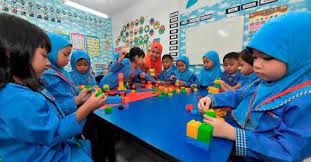[아시아 취학 전 교육②말레이] 유치원교육 통해 ‘국민통합’

교육과 훈육은 0세부터 시작된다고 합니다. 이를수록 효과가 높다는 얘기지요. 취학 전 아이들 교육에 대한 관심이 큰 까닭입니다. 사회주의를 택했던 중앙아시아 일부 국가에선 유치원 교육을 정부가 100% 맡는 나라도 있습니다. 몽골이나 이란의 유목지역에선 정부와 지자체가 유치원 교육을 앞장서고 있습니다. ‘과열’이 아니라 ‘제대로 된 방향’이겠죠? 아시아 각국의 취학 전 교육을 살피며 우리의 현실을 되돌아봅니다. <편집자>
[아시아엔=모하마드 나시르 유소프 전 <버나마통신> 선임기자] 말레이시아 아이들은 4~6세에 유치원에 다니며 영어 알파벳과 1, 2, 3과 같은 간단한 기본 지식을 습득한다. 말레이시아의 유치원 프로그램은 정부와 기업, 민간단체 등에 의해 제공된다. 유치원은 정부에 등록해야 한다. 국공립유치원은 비용이 낮은 반면 사립유치원은 등록금과 납입금이 높은 편이다.
교육통계 자료에 따르면, 말레이시아의 유치원 설립은 1970년대 초 농촌에서 시작했다. 이후 30여년 지난 2007년에는 농촌과 교외 지역에 8307개의 유치원이 건립됐다.
최근 집계에 따르면 2016년 기준 국공립유치원에 20만1000명, 사립유치원은 33만3000명이 재학 중인 것으로 나타났다.
말레이시아의 공립유치원에는 3가지 유형이 있었다. KEMAS 유치원은 8,307학급으로 약 19만9,000명(53%) 교육부 운영 유치원 5,905명, 유니티 유치원은 1,496명/ 약 3만9,000명/9.5%를 기록했다.
이후 경제발전과 함께 기업들이 풍부한 프로그램을 제공하는 사립유치원들이 늘어났다. 비싼 수업료를 감당할 수 있는 학부모들은 사립유치원에 아이들을 보내고 있다.
2008년 교육부 통계에 따르면, 4세에서 6세 사이 63만명이 유치원에 다녔는데, 약 40%가 사립유치원에 등록했다.
과거 국공립유치원은 시설과 교사들 수준이 사립유치원에 비해 크게 열악했다. 전문성도 떨어졌다.
사립유치원이 이슬람 쿠란 암송, 무술, 발레, 수영 수업과 같은 풍부한 프로그램을 제공하는 데 비해 공립유치원은 정부 목표에 보다 충실할 수밖에 없었기 때문이다.
하지만 최근 들어 국공립유치원의 결점을 정부가 적극 해결해 나가고 있다. 국공립유치원 교사들은 최소한 교원 자격증이 있어야 하고, 시설과 교재도 이전보다 업그레이드 되고 있다.
공립유치원에 다니는 자녀를 둔 저소득층 학부모들은 아이들이 유치원을 나와 읽고 쓸 줄 알고, 또래 친구들도 사귀는 모습을 보면서 흐뭇해 한다.
이슬람 유치원에 자녀를 보내는 학부모들은 일반 유치원과 달리 아이들이 쿠란을 암송하고 기도를 배울 것이라고 기대해도 좋다.
말레이시아 3200만 인구 중 문자 해독율이 1980년 69.5%에 머물렀으나 현재 약 98%에 이른다. 이는 정부와 비영리 교육기관과 민간기업이 앞다퉈 유치원을 설립해 교육에 나섰기 때문이다.
산간 벽지와 도서 지방같은 오지에도 유치원이 있다는 것은 말레이시아인들의 애국심 증진에 크게 도움을 줬다는 얘기와 다르지 않다. 말레이시아가 다인종, 다종교 국가임에도 불구하고 조화롭게 소통하며 평화를 유지하는 것은 교육 덕택이다.
말레이시아인들은 자국어를 존중하는 동시에 기본영어도 어려서부터 배울 기회를 갖고 있다. <번역 조일연 인턴기자>
Kindergarten ? The Blooms Of Malaysia’s Racial Harmony
by Mohamad Nasir Yusoff
Kindergarten programme in Malaysia is provided by the Government and several of its agencies, private bodies and voluntary organisations. Preschools centres are required by law to register with the Government. Public kindergarten charges some token or small registration and monthly fees while private kindergarten charges high registration and monthly fees.
Latest figure showed that in 2016, there were about 201,000 of 4-6 years old in government and government-aided preschool, while some 333,000 were enrolled in private kindergarten.
KEMAS kindergarten with 8,307 classes and total enrolment of about 199,000 or 53 %; Ministry of Education (MOE) kindergarten (5,905 / about 148,000/ 37.9 %) and Unity kindergarten (1,496/ about 39,000/ 9.5 %).
As Malaysia progressed, some entrepreneurs saw business opportunity in providing kindergarten with enriched programmes and thus many private kindergartens were offered. Many parents who can afford the higher fees opted for private kindergartens.
According to the MOE statistics in 2008, nearly 630,000 children aged 4 to 6 were enrolled in public or private preschools programme. About 40 percent were enrolled in private preschool programme.
However most of the minus points of the public kindergarten had been addressed by the government. Teachers at public kindergartens now must have at least a teaching diploma and had gone through proper training while facilities and teaching materials too have been upgraded.
Parents from the lower income group with children in public kindergartens would be glad enough if their children graduated from kindergarten able to read and write and have made some friends among their peers.
For Muslim parents with children in Islamic kindergartens, they expect their children can read, recite and memorise the Quran, and know how to perform the five daily prayers, apart from the standard achievement of normal kindergarten.
It could be partly due to efforts started by the government, non-profit organisations and also private companies in setting up kindergartens that Malaysia’s literacy rate now is at about 98 percent out of 32 million population, a huge increase from 69.5 percent in 1980.






